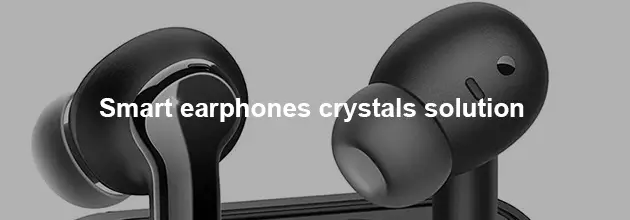Smart city monitoring and wearing a smart watch to monitor your health all require precise crystal oscillators
Smart city and health care Solution
To protect people and your assets which being monitor by a video security monitoring system, access control system, fire protection system, electronic examination room system, smart door lock, smoke alarm, gas leak alarm, anti-theft system and so on.
 |
 |
Application of crystal oscillators in smart wearables
Related questions
Can I set up wireless communications with the help of a quartz crystal oscillator only?
No, you cannot set up wireless communications with the help of a quartz crystal oscillator only. A quartz crystal oscillator is a component that's used in circuits to generate a precise frequency. It is used for timing, i.e., to provide a clock signal for purposes such as setting the speed of microprocessor or providing the stable carrier frequency in a communication device like a cell phone or a WiFi module. Wireless communication, however, involves much more than just a frequency source. It requires, among other things:
1.Transmitter: This takes some form of input signal (for example, speech), converts it into a form suitable for wireless transmission, and sends it out.
2.Receiver: This takes the transmitted wireless signal, converts it back into the original form (for example, back into audible sound), and outputs it.
3.Modulation/Demodulation Circuits: These are used to impose the information signal onto the carrier signal (this is done at the transmitter end) and to retrieve the original information signal from the received signal (this is done at the receiver end).
4.Antennas: These are needed both at the transmission and reception points, to send and receive the wireless signals.
5.Encoding/Decoding Circuitry: This is necessary to convert the data into a form suitable for transmission, and then convert it back into the original form at the receiver end.
The quartz crystal oscillator could contribute to the wireless communication by providing the carrier frequency, but by itself, it's incapable of setting up the whole wireless communication system.
Ceramic resonators are electronic components that, like crystals, can be used to provide a clock signal for an MCU circuit. While crystals have the advantage of higher precision and stability, ceramic resonators offer several benefits that make them more suitable for certain applications:
1.Cost: Ceramic resonators are generally cheaper than quartz crystals. This makes them a cost-efficient option for mass-produced devices where the price difference can be significant at scale.
2.Size: Ceramic resonators can be smaller than their crystal counterparts, which is beneficial in applications where space on the PCB is limited.
3.Ruggedness: Ceramic resonators are typically more robust and have better shock and vibration resistance compared to crystal units. This makes them suitable for applications where the device might be subject to rough handling or conditions that could damage a more delicate crystal.
4.Integrated Load Capacitance: Many ceramic resonators come with built-in load capacitance, which helps to reduce the number of external components needed in the oscillator circuit. This can further reduce costs and simplify the circuit design.
5.Easier to Handle: Ceramic resonators are less sensitive to handling and can tolerate a wider range of soldering temperatures. This makes them easier to work with during the manufacturing and assembly processes.
6.Faster Start-up Time: Ceramic resonators typically start oscillating faster than crystals when power is applied. This can be important in circuits where a quick start-up is necessary after power up or wake up from sleep modes.
7.Sufficient Accuracy for Some Applications: While ceramic resonators are less accurate than quartz crystals (typically 0.5% tolerance for ceramics versus 0.005% for crystals), they provide sufficient accuracy for many applications, such as consumer electronics, toys, and non-critical timing applications.
The choice between a ceramic resonator and a crystal often comes down to a trade-off between the cost and resilience of the resonator against the precision and stability of the crystal. For projects where accuracy isn't critical, and the other benefits of ceramic resonators are valued, they can be an advantageous choice.
The main purpose of the 32.768KHz clock oscillator in a microcontroller system is to provide a time base that is used for real-time clock (RTC) functions or any other timing operations in the system such as timing of instructions and operations, data transfer processes, system optimization, and peripheral controlling.
Here are the main reasons why 32.768KHz oscillators are commonly used:
1.Power Efficiency: A 32.768KHz oscillator is energy efficient. The low frequency requires less power compared to higher frequencies, making it suitable for battery-powered applications where power consumption needs to be minimized.
2.Binary Convenience: The specific frequency of 32.768 kHz is chosen because it is a power of 2 (2^15). This makes it especially convenient in digital systems. It is used for time-keeping because it can easily be divided down to yield one pulse per second, making it easy to track time increments.
3.Size and Cost: 32.768KHz tuning fork crystal oscillators are smaller in size and cheaper to produce than other types of high frequency crystal oscillators.
4.Wide Usage: The 32.768KHz is the industry standard for clock oscillators in microcontrollers and microprocessors, Real Time Clocks (RTC), watches, and other time-keeping devices due to their low power consumption.
It's worth noting that while the 32.768 kHz oscillator takes care of RTC functions, a microcontroller typically will have a separate, faster clock source for its main operations.